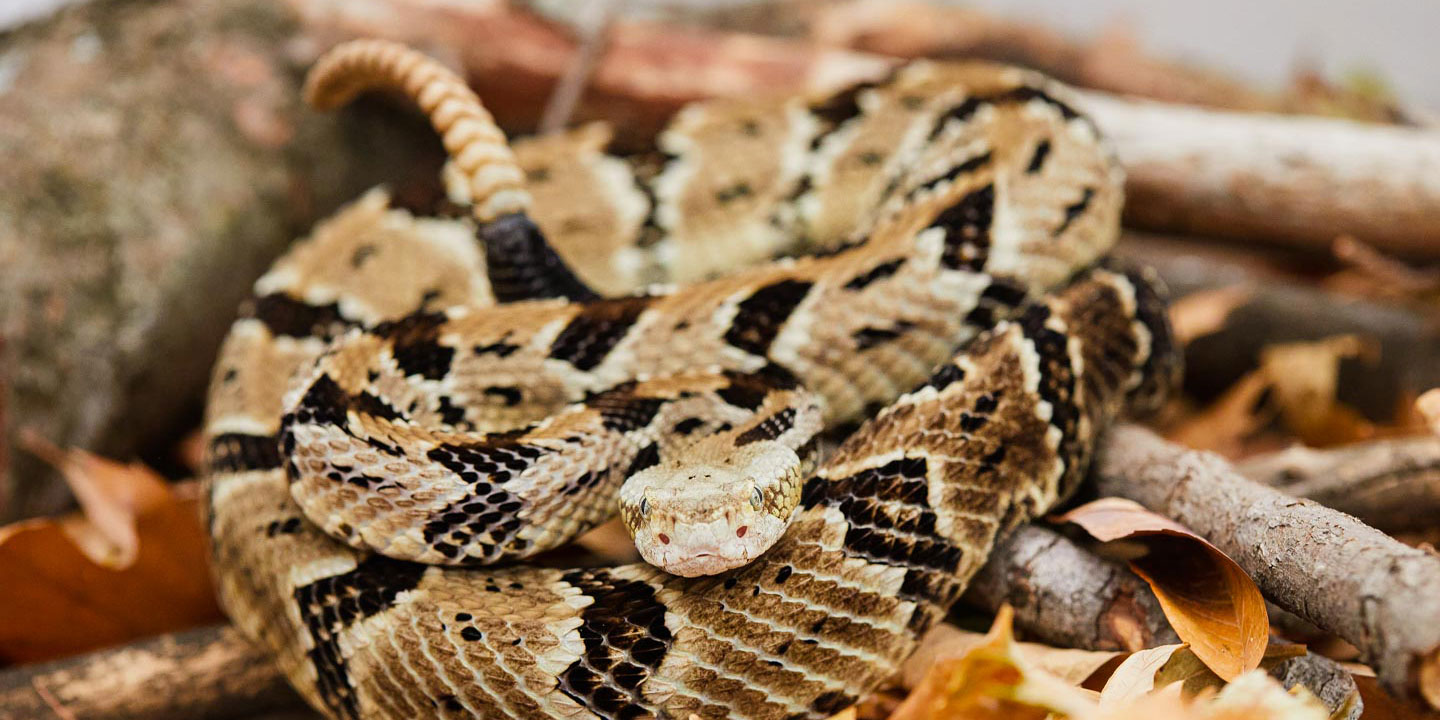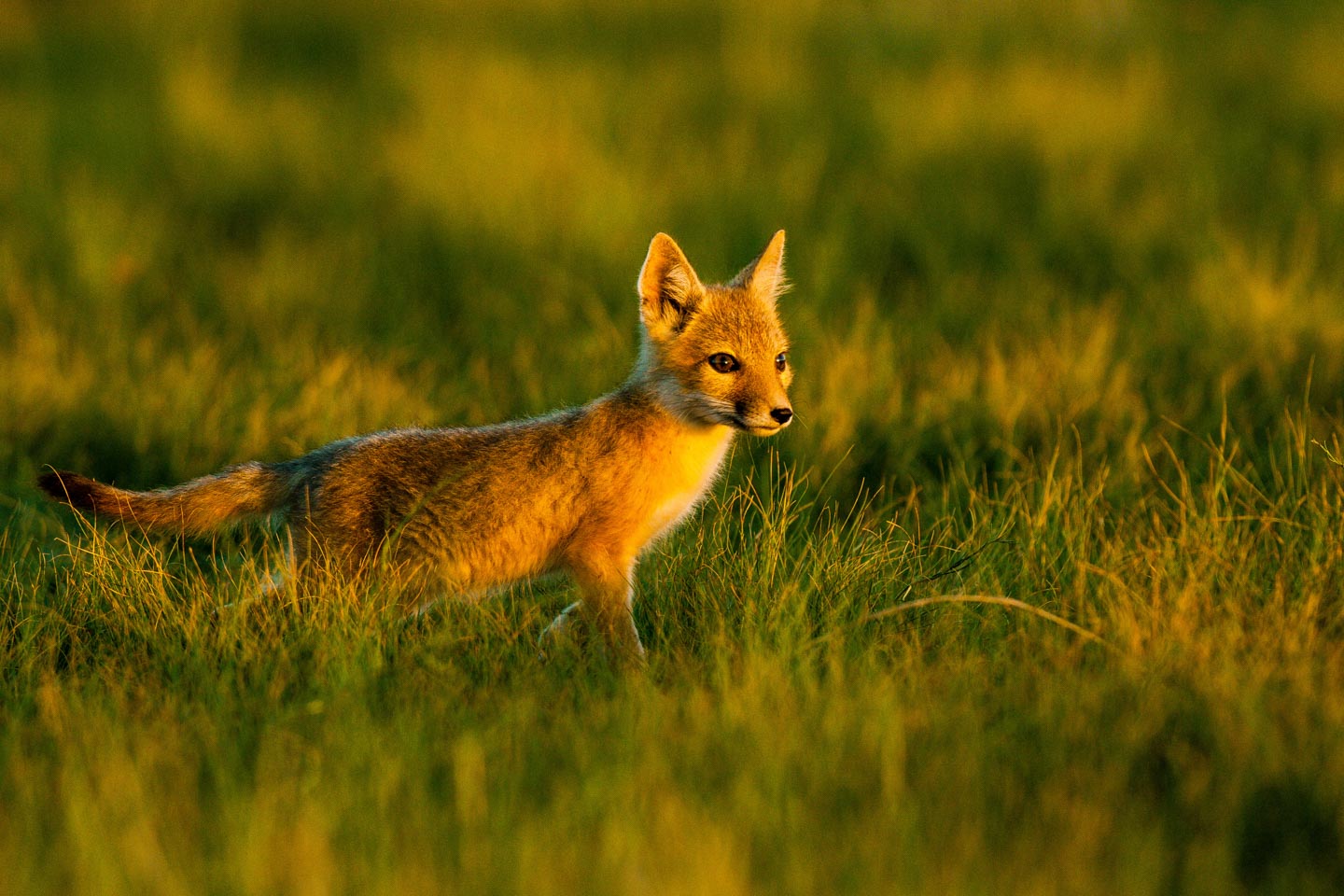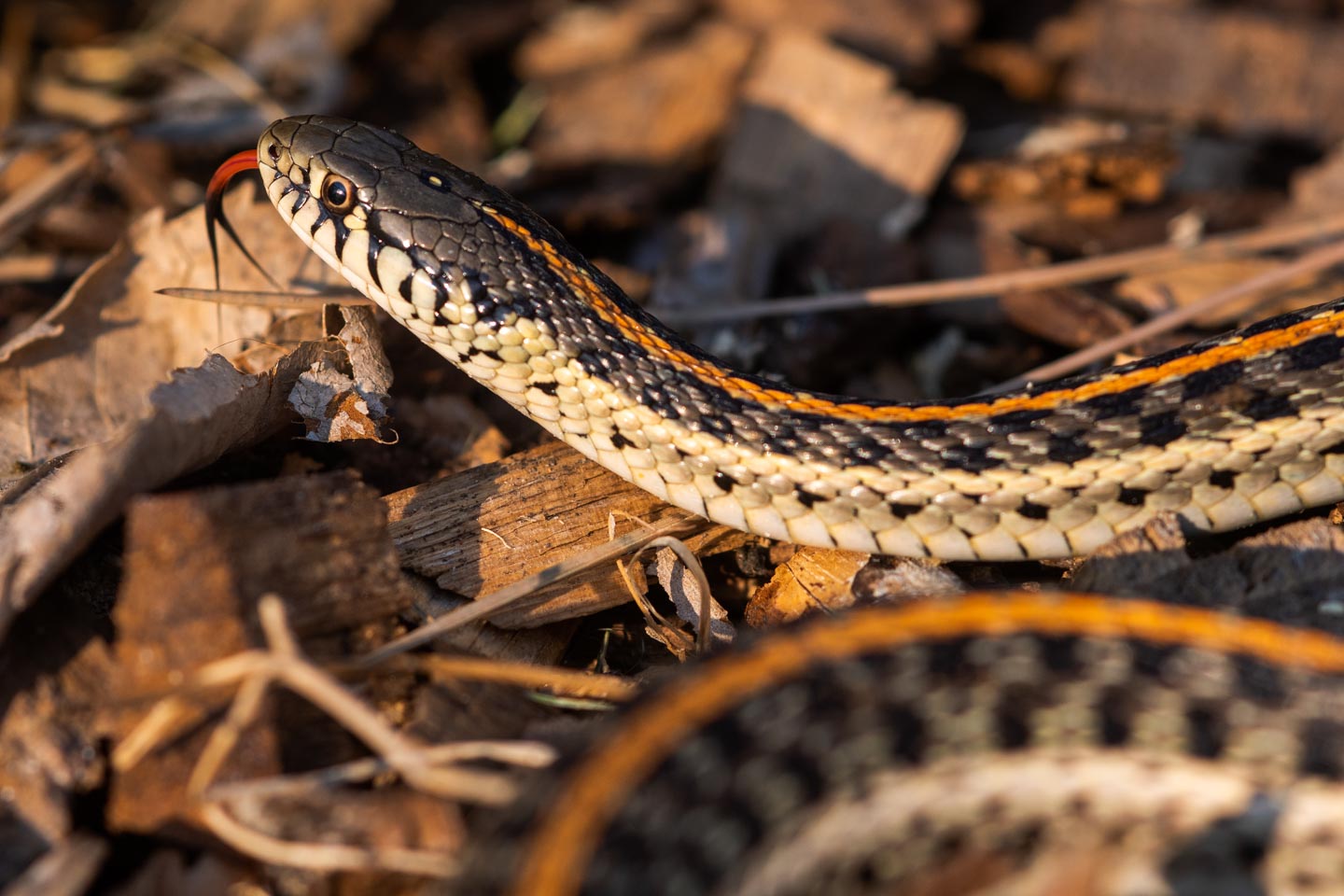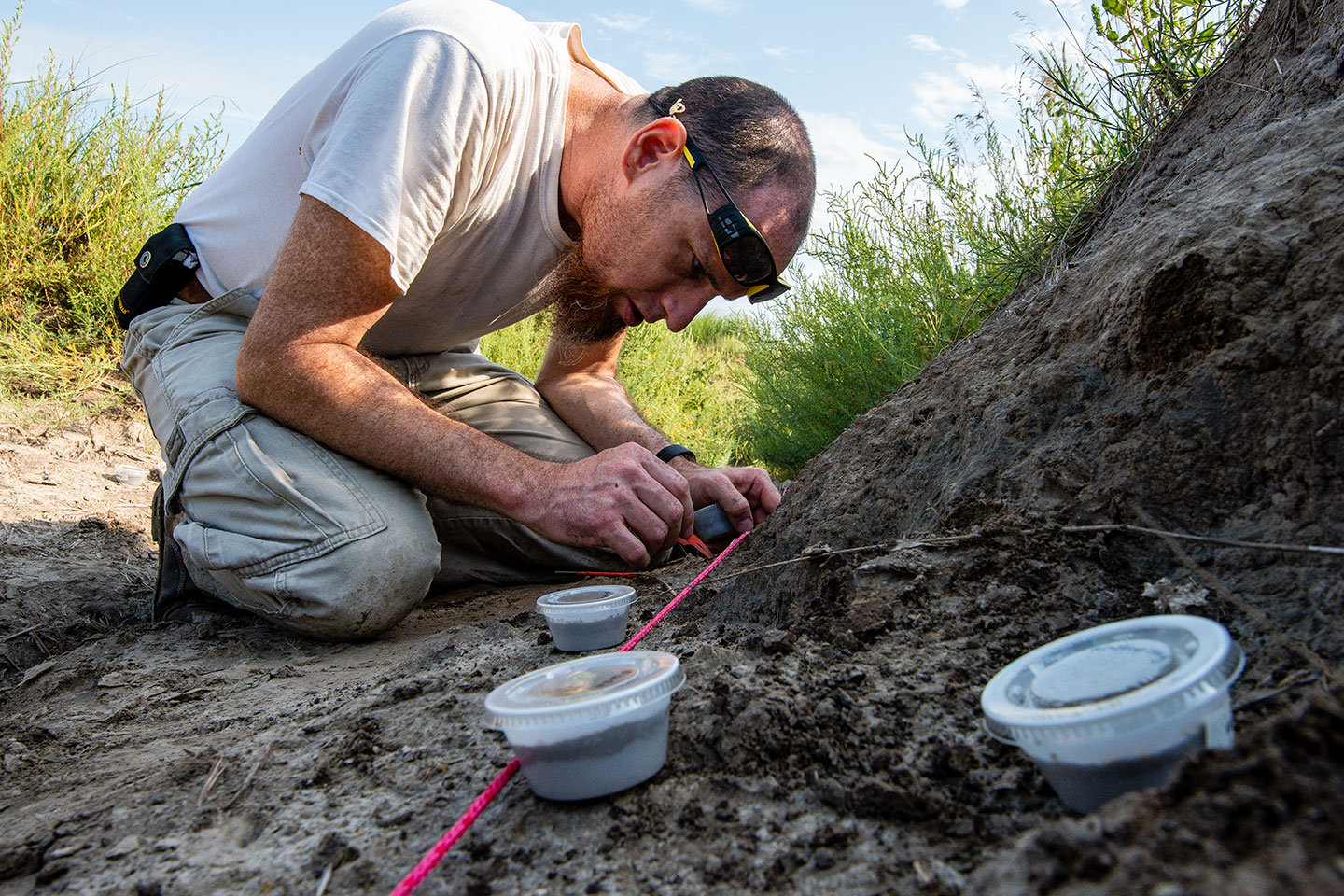Timber rattlesnake
Status: Threatened

The timber rattlesnake (Crotalus horridus) is Nebraska’s largest rattlesnake. It can reach up to 60 inches in total length, but on average ranges from 44.0-50.0 inches. It is a tan, gold, or light brown color with a series of black cross bands down the length of its body. Its distinguishing feature includes a reddish-brown dorsal stripe that extends from behind the triangle-shaped head to where the tail turns black. On the front of its head, from the nostrils to the cheeks extends a gold strip that passes through or just below the eyes.
Timber rattlesnakes can be found in woodlands, typically along streams in prairie uplands that include exposed clearings of rocky outcrops or talus slopes. They use grasslands for foraging or migrating between woodland areas and have been known to move through agricultural fields. Timber rattlesnakes can exhibit certain levels of den fidelity for their hibernacula, meaning they typically return to the same den year after year.
Since timber rattlesnakes are ambush predators, they deploy a “sit-and-wait” technique for locating prey. When disturbed, timber rattlesnakes sound a warning by rattling their tail. Only rattlesnakes have the specialized sound producing rattle on the tip of their tails.
Venomous snakes produce a highly toxic saliva that can be used for killing prey, defensive action, and to assist with digesting food. There are known deaths due to timber rattlesnake bites, and extreme caution should be taken if a timber rattlesnake is encountered. In the event of a bite, seek emergency medical assistance immediately.
Timber rattlesnakes are also known as Banded Rattlesnake, Velvet-tail Rattlesnake, and Canebrake Rattlesnake.
Range
Timber rattlesnakes have a wide distribution that covers a majority of the eastern half of the United States, although approximately half of the U.S. states consider it a species of in need of conservation.
In Nebraska, timber rattlesnakes are present in the far southeast portions of the state in the southern parts of Jefferson, Gage, and Pawnee counties and along the limestone bluffs of the Missouri River. Nebraska’s population is at the western edge of the species’ range in the United States.
Habitat
Timber rattlesnakes are found in woodland areas along streams characterized by occasional exposed clearings of rocky outcrops. The have been known to use grasslands to forage for food or migrate between woodlands. Over the winter, timber rattlesnakes hibernate in cracks within bedrock called fissures.
At the beginning of April timber rattlesnakes emerge from their hibernacula, or wintering dens, and stay active until the beginning of November. They can be found basking, foraging, and searching for mates.
Diet
Timber rattlesnakes use fallen logs or debris as a place to hide and wait for prey to pass by. The waiting behavior allows timber rattlesnakes to save energy to be more effective and successful when hunting. They prey on small mammals such as mice, chipmunks, ground squirrels, and voles, but they will occasionally eat birds, amphibians,
or reptiles. The most common snake they prey on are garter snakes. Due to their smaller size, juvenile timber rattlesnakes typically consume smaller prey such as shrews.
Reproduction
Timber rattlesnakes are a slow-growing and long-lived species. The lifespan of a timber rattlesnake can range from 16 to 22 years. Males reach sexual maturity at approximately 5 years old, while females can range from 5 years to 11 years before being able to reproduce.
The breeding season ranges from August through September. Females can reproduce at 2–4-year intervals and give birth to a litter size from 4-15 neonates. Timber rattlesnakes are viviparous, meaning they give birth to live young. This is an adaptation to colder climates due to insufficient time for eggs to incubate outside of the body.
Population status
The biggest threat to timber rattlesnakes is habitat loss. Habitat loss includes the destruction, modification, or curtailment of suitable habitat or range. Since woodlands are rare in Nebraska, and suitable hibernation habitat is also scarce, timber rattlesnakes are limited in where they can reside over the winter. Encroaching eastern red cedar (Juniperus virginiana) causes shading over den sites that require exposure to the sun during the winter months. Furthermore, there are some locations with rocky outcroppings in Nebraska that are quarried for rock ultimately destroying habitat for hibernacula.
Human interaction with timber rattlesnakes is another serious threat. Snakes are often killed on roads by traffic, either accidentally or maliciously.
Management and outlook
Timber rattlesnakes will benefit by the prohibition of any large-scale alterations to their habitat and hibernacula. To aid in protection, comprehensive field surveys are conducted to determine where dens are located within the state. Once habitat and hibernacula sites are recorded, woody vegetation can be regularly removed via a combination of prescribed burning and pruning. This not only prevents the over-shading of hibernacula sites but opens additional habitat for small mammals the rattlesnake can prey upon.
Conservation help
The first step in conservation action for timber rattlesnakes begins with educating the public and landowners on the habitat timber rattlesnakes require to help with safety concerns. Timber rattlesnakes are never waiting patiently to strike a human, however, like any animal, if startled or mishandled they will react with their instinctual behavior. If you see a timber rattlesnake, stop, and do not approach it.
The next step is to reframe the mindset that timber rattlesnakes are a hazard. Like many other protected species nationwide and internationally, there is an appreciation to have encountered a rare and special species. This is especially true if a timber rattlesnake is found on a landowner’s private property, and they take pride in have “their” rattlesnakes. Threatened and endangered species are seldom found in the wild unless sought out, and it is worth investing in cultivating gratitude for a state- threatened species, no matter their perceived risk.
Anyone can report illegal harassment of all snake species to the Nebraska Game and Parks Commission. Individuals also can make donations to conservation organizations dedicated to preserving or restoring timber rattlesnake habitat and educating the public.
References
A Field Guide to the Amphibians and Reptiles of Nebraska. 2010. Fogell, Daniel D.
Panella, M.J., D.D. Fogell, and C. Rothe-Groleau. 2022. Timber Rattlesnake (Crotalus horridus): a species conservation assessment for the Nebraska Natural Legacy Project. Nebraska Game and Parks Commission, Lincoln, Nebraska.
Alvin R. Breisch, W. H. Martin, John B. Sealy, Christopher E. Petersen, and Earl Possardt (eds.). 2021. The Timber Rattlesnake: Life History, Distribution, Status, and Conservation Action Plan. Partners in Amphibian and Reptile Conservation Technical Publication CAP-1. Published by Amphibian and Reptile Conservancy, Inc. Nashville, TN.
Clark, Rulon W., et al. “Decline of an isolated timber rattlesnake (Crotalus horridus) population: interactions between climate change, disease, and loss of genetic diversity.” Biological Conservation 144.2 (2011): 886-891.
Reinert, Howard K., David Cundall, and Lauretta M. Bushar. “Foraging behavior of the timber rattlesnake, Crotalus horridus.” Copeia (1984): 976-981.
NOTE: New data of the occurrence and distribution of this species are being collected constantly and some of the information in the pamphlet may be outdated. The information in this pamphlet should be used for a general understanding of the species and not as the sole source of range location for any report, project, regional or local planning, or for environmental impact assessments. For current information on this species, please contact the Nebraska Game and Parks Commission, Wildlife Division.



